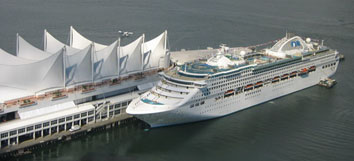Vancouver Port ties harbour fees to emissions
 Vancouver, Canada (GLOBE-Net) – Ships entering the Port of Vancouver will now be charged harbour fees based not only on their weight, but on their air pollution emissions as well.
Vancouver, Canada (GLOBE-Net) – Ships entering the Port of Vancouver will now be charged harbour fees based not only on their weight, but on their air pollution emissions as well.
The Vancouver Port’s new Harbour Dues Program, effective April 1, 2007, will assess lower fees to ships that meet certain standards for reduction of air emissions.
The differentiated rates (Basic, Bronze, Silver and Gold) are designed to provide a wide variety of technology and fuel options to vessels in order to promote and build awareness around a number of alternative emission reduction practices.
The Gold air emission standard is at a level that will be attained by leading edge vessels, and will require ships to use ultra-low-sulphur diesel fuel, to install technologies to reduce air pollution, and to have the capacity to turn off diesel engines and plug into shore power while at dock, also known as ‘cold-ironing’. The Bronze standard is designed to be achievable by many vessels that currently call in the Port.
Ships that achieve the Gold Standard will be assessed harbour fees at a rate of $0.057 per Gross Registered Tonnage (GRT), while those meeting the Bronze level will be charged $0.077 per GRT. Depending on the size of the vessel and the number of visits it makes to the Port each year, the cost difference should encourage investment in technologies to reduce pollution.
Details on the new fee structure can be found here.
The Port of Vancouver is Canada’s busiest port, with more than 70 million tonnes of cargo and close to one million passengers annually. Currently, marine-related sources produce more than one-third of sulphur dioxide and nitrogen oxide emissions in Vancouver and the Lower Mainland. By 2010, marine air pollution is expected to overtake light-duty motor vehicles as a contributor of smog-forming pollutants.
In response, the Vancouver Port Authority (VPA) has undertaken a program aimed at reducing emissions by an amount that would compensate for any projected growth in the next 10 years.
Initiatives include emissions standards for trucks servicing the port, pilot programs to demonstrate new clean technologies, and support for a joint Canada-U.S. effort to have North America declared a Sulphur Emission Control Area (SECA), which would limit sulphur content in ship fuel to 1.5 percent.
While the application is still underway, the new Harbour Fees structure could lead to more widespread use of low-sulphur diesel, with a potentially significant reduction in air pollution from shipping traffic.
“Reducing port-related emissions, including those from marine vessels, forms a key component of meeting our commitment to sustainable port operations,” said Gordon Houston, President and Chief Executive Officer of the VPA. “We are working very hard to integrate environmental, social and economic sustainability initiatives into all operations, and the new Harbour Dues program is an excellent example of how we can strive to be leaders in environmental stewardship through a business initiative.”
For More Information: Original Source
You can return to the main Market News page, or press the Back button on your browser.

